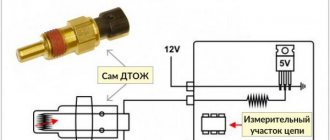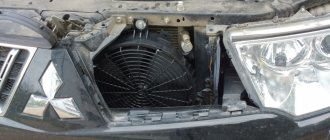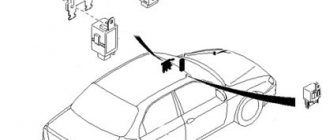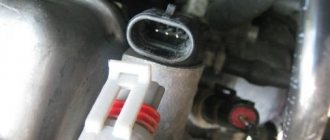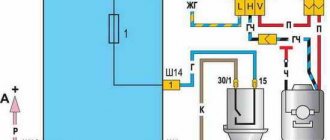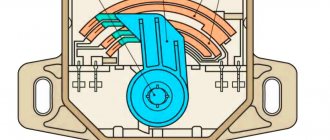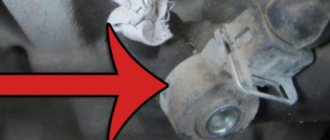What to do if the cooling fan on the VAZ-2110 does not turn on
The VAZ-2110 is often called the “ten” among drivers. Among such vehicles, one of the main problems is the breakdown of the heating and cooling system. The problem is unpleasant and causes considerable trouble for its owner, but it is quite easy to deal with it even with your own hands, without contacting a service center, and you will save a considerable amount. This article will tell you what to do if the cooling fan on the VAZ-2110 does not turn on.
On average, a new purchased cooling fan for a VAZ-2110 ranges from 1 to 2.5 thousand Russian rubles. However, replacing its individual faulty parts will cost much less.
The cooling fan does not turn on on the VAZ-2110: what to do
When planning to dismantle the cooling fan on a VAZ-2110, it is important to know the operating principle of the entire system. A variety of problems can cause a cooling fan to fail, such as:
- breakdown of the electric fan (starts only if the coolant temperature is maintained at 100 degrees);
- the fan switch sensor is broken (it works only in a certain temperature range, located at the base of the inlet pipe of the cylinder block);
- failure of the mounting block fuse;
- Malfunction of the cooling fan relay (located on the right panel of the front console of the vehicle).
When the expansion tank fuse fails, having internal atmospheric pressure, the internal liquid - antifreeze - will take on a boiling state, but the fan will still not be able to start, and in this case the problem will not be in the electrical circuit. The fact is that the VAZ-2110 has an injection type, which means that the fan will start only when the temperature is +100 °C. In this case, the expansion tank cap needs to be replaced. Provided that it is possible to maintain a pressure greater than atmospheric pressure inside, the boiling point will rise slightly, and this will allow the fan to start working.
If, however, the reason lies in a malfunction of the electrical circuit, then it is necessary to diagnose it. This is done as follows:
- First, the functionality of the mounting block is checked, making sure that the contacts are in good condition with oxidation. If you are not satisfied with something externally, change the fuse or clean the contacts.
- Now you need to examine the condition of the fan switch sensor. Start the vehicle engine and warm it up to 100 degrees. Next, turn off the car and start it again. Under the hood, remove the terminal from the fan sensor and see how the fan behaves. If it starts, the sensor must be replaced.
- Then we move on to inspecting the electric motor. If all previous inspections of the parts have not yielded results, then there is nothing left to do but remove the electric motor and check the electric motor. There can be a huge number of problems with it: wear of the commutator brushes, their freezing, short-circuiting of the armature winding (in this case a pungent odor will emanate).
- The last step is to check the functionality of the fan relay. If the whole problem is the fan start button not working, then you will need:
- remove the right console trim from inside the car, removing all fastening screws;
- find the relay we need (1 of 3);
- replace it with a new one.
In the case when the cooling fan on the VAZ-210 works constantly without turning off, both in hot and cold engine states, then troubleshooting can be different:
- if the contacts of the electric fan responsible for turning it on do not open, then the test is carried out using a multimeter, and if a breakdown is detected, the part is replaced with a new one;
- in the event that the temperature sensor or its circuit is broken, then it is diagnosed using an ohmmeter, and, in the event of a breakdown, a new sensor is installed;
- if the control unit of the injection system is broken, then the unit must be taken to specialists for inspection and its ECU or the entire unit must be flashed;
- if the thermal switch has open contacts, then the terminals that are the terminals of the thermal switch are disconnected and a new one is installed.
Even such a careful diagnosis of each part of the cooling system on the VAZ-2110 may not give any positive results, and the fan, as before, will not start working. Here you cannot do without consulting experienced specialists; you will have to take the car to a service center. There, the entire cooling system will be put through computer diagnostics to determine what is causing the cooling fan failure.
If your financial situation allows you to periodically visit auto repair shops, then by all means do so. No matter how you know your car, they will better analyze it and conduct a thorough diagnosis, allowing you to anticipate multiple breakdowns that could interfere with the implementation of your plans.
Methods of testing for functionality
There are several ways to diagnose the antifreeze temperature controller - visually and using a tester. Before arming yourself with a multimeter, you should carefully inspect the device’s case. If it shows signs of corrosion, deposits or damage, this indicates that the regulator needs to be replaced.
As for checking with a multimeter, the procedure is as follows:
First, the device should be removed; to do this, you just need to find its installation location, turn off the power and unscrew the device. Next, you will need a container to fill with refrigerant. The next step is to heat the container after you put the DTOZH in it. But before that it should be connected to the tester probes
Please note that when diagnosing, you must know exactly the heating temperature level of the liquid; this is what will allow you to determine the performance of the controller. The container heats up, and you will need to compare the results obtained with those indicated in the table
The table itself is shown below. If the temperature level does not correspond to the nominal resistance value or vice versa, this indicates a malfunction of the device. Too high a signal level from the coolant temperature sensor also indicates its failure. There are cases when the problem, when the values are higher than optimal, can be solved by cleaning the surface of the device, but such measures, as a rule, help if the deviation of the indicators is insignificant (author of a video about self-diagnosis of DTOZH - channel Device and car repair).
We measure the temperature at which the fan turns on on a VAZ-2110: injector and carburetor
Maintaining normal engine operating temperature is very important to maintain engine performance. The cartoon arrow on the instrument panel, of course, shows the temperature not at all accurately and gives, rather, approximate indicators. The electronic engine control system of the VAZ-2110 with any injection engine uses completely different data, more accurate. They affect the operating temperature and the frequency of turning on the cooling fan.
When does the radiator fan turn on on a VAZ-2110
To really understand how to change the fan switching temperature on a VAZ-2110 injector, you need to know exactly the factory design parameters and the principle of fan switching itself.
In carburetor engines, the fan turned on at about 100 degrees.
On old-style 2110 carburetor engines, the fan was turned on using a thermobimetallic sensor. It was installed directly in the radiator bank and set to a certain temperature. Since the normal operating temperature of antifreeze is 80-90 degrees , the bimetallic plate made contacts at approximately 100-105 degrees .
In injection tens, the fan starts in a completely different way. There are two temperature sensors installed near the thermostat - one with one wire, the second with two. The first one is responsible only for the temperature indicator needle, so there is little demand from it. The second sensor with two wires is working. It is he who supplies the impulse to the electronic engine control unit, which then supplies power to the fan motor network.
Features of the temperature sensor
However, one must understand that a temperature sensor is a conventional converter of thermal energy into a variable electrical pulse. More precisely, when the temperature of the antifreeze changes, the resistance of the sensor changes approximately in this mode:
| Antifreeze temperature, °C | Resistance, Ohm |
| 100 | 123 |
| 80 | 215 |
| 60 | 667 |
| 40 | 1459 |
| 20 | 3520 |
| 9420 | |
| -20 | 28680 |
| -40 | 100700 |
Now the principle of operation of the fan activation system becomes clear - the ECU receives a certain electrical impulse when the temperature reaches 110 ° C (133 Ohms) and supplies power to the fan motor.
As soon as the resistance of the sensor element rises to 187 Ohms (which corresponds to 97 °C), power is removed from the fan and the engine cools down.
Checking the fan motor
table fan Vitek
Let us consider in detail how the fan motor is checked. As an example, an electric motor corresponding to the version of household table fans is shown.
The photograph shows the small electric motor of photo #1 of the table fan. To present this topic more clearly, the explanation will be accompanied by personal photographs of the diagnostics of the electric motor.
Carrying out diagnostics of electrical connections begins with a preliminary check of the device itself, photo No. 2.
Why is such a check necessary? — The check is carried out to ensure that the probe wires of the device do not have a break. That is, in practice, such a malfunction of the device often occurs as a break in the wire in connection with the probe or a metal pin in connection with the wire.
If there is a break, for a certain section of the electrical circuit, the display of the Multimeter device shows “one”. If two probes of the device are short-circuited with each other when the range of least resistance is set, the display of the device will show a zero resistance value. For this example, this will mean that the device is operational.
How to change the temperature?
Over time, more and more complaints appear about the operation of the cooling fan activation system. The most important design flaw is the lack of several fan operating modes and the abrupt start of its motor . Indeed, in the summer heat the fan has to work at full strength, and this is understandable. However, most often the fan produces excessive performance, which leads to rapid cooling and frequent starts.
This leads to a current overload on the on-board network.
In addition, the starting temperature threshold is too high, so the engine often overheats . Unfortunately, you can only change the fan startup parameters by reflashing the electronic control unit or upgrading the electric motor activation system. Reflashing the ECU is carried out by a competent specialist, and it is possible to set any desired temperature for turning the fan on and off.
Basic methods
Diagram for connecting an additional fan sensor.
There are also several solutions to changing the operating modes of the fan motor. The simplest of them is to install an additional switching sensor from carburetor engines (in the diagram above). It is configured to turn on at a temperature of 97-100 ° C , which will be quite enough. And in order for the fan to operate in this mode at half power, a resistance from the VAZ heater is installed in the circuit.
How does the radiator cooling fan sensor work?
To understand how to test a sensor, you must first understand its operating principle.
The design of the radiator cooling fan sensor is very simple, but it is somewhat different on carburetor and injection engines. In a carburetor, it has two contacts and a bimetallic plate. When the bimetallic plate is heated to a temperature determined during the production of the sensor, the contacts close and current begins to flow through them to the fan, turning it into operation. On the injector, the sensor activation system is almost the same, except that the command to turn on is sent by the engine control unit, analyzing the need to activate the fan based on information coming from several other sensors.
Sensors on carburetor engines operate when a certain temperature is reached, and the driver can look at the markings on the device body to determine in what temperature range the sensor will operate. Typically, such sensors are activated at temperatures between 92 and 97 degrees Celsius. If the driver is concerned about possible engine overheating, he can find a sensor on sale that operates at a lower temperature and install it. On injection engines, the sensor response temperature is stitched into the “brains” of the car control unit.
VAZ 2110 injector cooling fan does not work
An engine operating at extreme temperatures will require expensive repairs or replacement. How to organize uninterrupted engine cooling? Why does the VAZ 2110 injector cooling fan not work?
A 10-minute reading will provide answers to these and many other questions. The article is based on the generalized experience of professional mechanics and auto electricians. Clear, proven tips will help you find and troubleshoot problems and avoid unwanted breakdowns.
Safety valve
Knowing physics, you will agree that at normal atmospheric pressure, the water that is part of antifreeze boils at a temperature of 100 degrees Celsius.
Old device
If the VAZ 2110 cooling fan fuse, that is, the valve located on the expansion tank cap, turns out to be faulty, and there is atmospheric pressure inside it, the cooling liquid will boil, but the fan will not be able to start working even with a working electrical circuit. This is because the fan switching sensor on the injection VAZ 2110 has a switching temperature of more than 100 degrees Celsius.
To fix this problem, replace the expansion tank cap. The new element must maintain the pressure inside the system above atmospheric pressure, which will allow the laws of physics to work, the boiling temperature to rise to 105 degrees Celsius and thereby turn on the blades of the unit.
Article on the topic: Replacing the boot of the outer CV joint on a VAZ 2109 (Video)
The principle of operation of the cooling system of the VAZ 2110 injector 16 valves
The design is a closed circuit, inside which coolant is pumped through a centrifugal pump. The radiator releases the temperature generated by the engine into the atmosphere. The sensor installed on the thermostat pipe senses the coolant heating threshold of 105 - 107 degrees Celsius, provides information to the controller. The controller sends a signal to the relay, starting the electric motor of the fan. The radiator honeycombs are blown.
The principle of operation of the cooling system of the VAZ 2110 injector 16 valves: 1 - heater radiator; 2 — coolant drain hose from the heater radiator; 3 — coolant supply hose to the heater radiator; 4 — coolant pump hose; 5 — expansion tank hose; 6 — steam removal hose of the heater radiator; 7 — expansion tank cap; 8 — expansion tank; 9 — thermostat; 10 — coolant drain hose from the engine radiator; 11 — hose for supplying fluid to the throttle assembly; 12 — steam exhaust hose of the engine radiator; 13 — hose for supplying fluid to the engine radiator; 14 — engine radiator; 15 — radiator drain plug; 16 — electric engine radiator fan; 17 — coolant pump; 18 — supply pipe of the coolant pump; 19 — coolant drain hose from the throttle body.
Safety regulations
- Open the expansion tank cap after the engine has cooled down.
- When working under the hood, beware of rotating blades and a hot engine.
- Use auxiliary, serviceable conductors with a cross-section of 2 mm.
- Use standard fuses of the required rating.
- Use a proper tool.
- Insulate “bare” contacts, avoiding short circuits in the electrical wiring.
The design of the cooling system and the principle of turning on the fan
Engine temperature indicator
Before we begin to directly consider the temperature at which the cooling fan turns on, it is worth understanding the operating principle itself. So, coolant circulates through the system and removes heat from the engine to the radiator. This element, in turn, conducts natural cooling of the liquid with a counter flow of air.
Before considering all the factors and the temperature at which the fan turns on, it is worth understanding the design of the cooling system and the circulation of coolant:
Engine device
1 – element in the form of a plug for the expansion tank; 2 – expansion tank; 3 – hose for draining liquid from the pipe; 4 – hose passing between the radiator and the expansion tank; 5 – hose leading from the radiator; 6 – tank to the left of the radiator; 7 – aluminum tube; 8 – plug systems; 9 – tank to the right of the radiator; 10 – drain plug; 11 – middle of the radiator; 12 – casing for electric fan; 13 – plastic wings of the electric fan; 14 – electric motor; 15 – toothed pump pulley; 16 – pump impeller; 17 – camshaft drive belt; 18 – engine block; 19 – pump pipe; 20 – radiator hose with supply function; 21 – heater radiator hose with drain function; 22 – hose supplying coolant to the throttle pipe; 23 – exhaust pipe; 24 – hose for refilling; 25 – heater radiator hose with supply function; 26 – thermostat; 27 – coolant temperature sensor; 28 – coolant level indicator sensor.
What should the engine temperature be?
According to the international automobile convention of December 1, 1992, where 92 representatives of the auto industry gathered, it was decided to establish a single standard for engine operating temperature.
Cooling fan connection diagram
But, given the region of operation and the ambient temperature, this temperature tends to rise. It is for this purpose that automakers came up with a cooling system fan, which provides additional cooling of the fluid in the system. It is driven by a temperature sensor, which detects it in the engine and is located directly on the power unit.
When the fan on the VAZ-2114 turns on
Thus, for normal engine operation, the system temperature should not rise above 105 degrees. This indicator is the starting point for turning on the cooling system fan. This data is stored in an electronic control unit, which regulates the operation of the fan.
The fan switching circuit looks something like this: the engine temperature reaches 105 degrees Celsius, then the sensor sends a signal to the ECU, which turns on the fan and stops it when the temperature in the system reaches 93-99 degrees Celsius.
Cooling temperature sensor
In summer and winter, as practice shows, the fan turns on at different temperatures and for different periods. In summer, forced cooling will turn on more often as the radiator is cooled by the hot air flow. In winter, the fan almost does not turn on or its operation is limited to a short period, since natural cooling is quite sufficient. Therefore, the main radiator breakdowns occur in the warm season.
Possible cooling fan malfunctions
The driver notices that the temperature on the device has reached a threshold value. There is no fan noise. You should urgently choose a safe place and stop. Turn off the ignition. Operating the engine at a temperature above the threshold for 20 minutes causes irreversible consequences.
There are seven known reasons why the fan on a VAZ 2110 does not turn on.
- The safety valve of the tank is stuck and not sealed.
- The integrity of the conductors is broken, there is poor contact at the connection points of the circuit elements.
- The fuse link on the control panel has burned out, there is no contact in the fuse sockets.
- The temperature sensor is faulty.
- The relay for turning on the electric fan drive is damaged.
- The fan motor has burnt out.
- The controller is faulty.
Procedure. Step-by-step instruction
If after completing the next step the problem goes away, further checks are stopped.
- Open the hood.
- Wait for the engine to cool down.
- Perform an initial visual inspection: integrity of the hoses, reliability of the clamps, absence of leaks or cracks.
- Make sure that the expander cover elements are in good condition. Remove scale, rust, clear holes, wipe, assemble. The absence of noticeable damage to parts gives hope that the product will work.
The valve design is elementary. The cover contains a spring. Functionally, it is designed to regulate the pressure in the cooling circuit. A hot engine increases it, a cold engine decreases it.
Compressing at a value of 1.1 atmospheres, the spring relieves excess pressure and prevents the destruction of hoses and the tank. As the motor cools, it creates a vacuum effect. The tank will begin to flatten. The valve equalizes the pressure.
The lid screws tightly on the thread, eliminating distortions. There should be a gap between it and the body. An overtightened valve will not work. It is difficult to test the device's operation in road conditions. You can check by replacing it with a known good one.
Inspect the electrical wiring elements to ensure a reliable connection
Possible factors for damage to electrical circuits:
- vibration;
- oxidation;
- burning;
- breakage, fraying of electrical wires;
- insulation aging, short circuit.
Switch the tester to resistance measurement mode. Remove it with special tweezers and ring the fuse link F7 located in the mounting block.
Fuse box diagram
Attention! It is important to find out and eliminate the cause of burnout.
Replace the burnt-out element with a serviceable one with a rating of 20A. Inspect and clean the nest. Insert fuse.
It was not possible to find out the reason, the protection triggered again - look for a short circuit.
Disconnect the fan plug. Use a tester to measure the circuit of the electric motor windings. Zero resistance or a break indicate the need to replace the radiator blower electric drive.
Interturn short circuits that cause multiple replacements of fuse links cannot be measured with the device.
Sensor check
Start the car. Pull out the coolant temperature sensor connector. The fan starts working - the sensor needs to be replaced. Secure the disconnected wire. Drive to a nearby service station.
Relay test
There is a hatch on the floor at the front passenger's feet.
Below it is a built-in panel with three relays of the same type:
- fan installation;
- fuel pump;
- ignition (main thing).
By replacing each other, try to start the airflow. The VAZ 2110 fan does not work - go to the next step.
Where is the VAZ 2110 cooling fan relay located?
If you are wondering where the fan relay is located on a VAZ 2110, then this photo below will answer your question and you can easily find where the cooling fan relay is located on a VAZ 2110.
VAZ 2110 fan relay
Check the electric motor
Winding measurements did not reveal a malfunction. Apply voltage briefly from the battery using additional insulated conductors. The operation of the fan indicates a malfunction of the controller, which does not output a signal to the relay.
- The only correct solution is to turn on the airflow directly and urgently visit a service station.
- Prevention of breakdowns of the cooling system of the VAZ 2110 injector 16 valves.
- Periodically inspect the components of the cooling system.
- Monitor the cooling temperature on the device, listen to the operation of the fan.
- Maintain coolant level. Replace after 2 years or 30,000 km.
- Use the solution to remove rust and scale.
- Signs of a change in the properties of the coolant are a change in color, an increase in fluidity.
- Check the density with a hydrometer.
- Do not mix coolants.
- Every twelve months, rinse the expansion tank cap with water and check it on a stand with a pressure gauge.
- Avoid contact of aggressive liquids with electrical wiring and electric motor windings.
Improvements to the fan start control circuit for the VAZ 2110 injector
The smooth functioning of the engine worries factory designers, auto mechanics, and car enthusiasts. Folk craftsmen change the design of valves and electrical circuits.
Installation of three position toggle switch:
- continuously on: the VAZ 2110 cooling fan does not work;
- constantly switched off: warming up the engine when starting in the cold season, automatic control is faulty;
- automatic mode: controlled by the controller, the equipment is working properly, the algorithm is executed correctly.
When choosing an installation location, consider the following conditions:
- prevent accidental switching;
- not to be confused with other controls.
It is important to remember when modifying the design about the safety of the changes made.
Design and testing of the VAZ 2110 fan switch sensor
To maintain optimal temperature conditions of the car engine, a cooling system is designed. Its main elements are channels for antifreeze in the cylinder block, pipes, a thermostat, a radiator, and the electrical part includes a VAZ 2110 fan switch sensor, a temperature sensor and an electric motor with an impeller for cooling the radiator. Late detection of cooling system defects can lead to engine overheating and costly repairs.
Connection schemes
In VAZ 2110 injection and carburetor engines, the TM-108 bimetallic temperature sensor is used in different ways to control turning the fan motor on and off.
For carburetor engines it is located on the radiator on the left in the direction of travel. When the threaded part located directly in the coolant is heated, the bimetallic plate bends and closes the contacts. The voltage from the battery is supplied through a fuse to one contact of the electric motor, the second, when the sensor is triggered, is connected to the housing, setting the impeller in motion.
For VAZ 2110 and TM-108 injectors, it is located near the thermostat, the signal is sent to the electronic control unit (ECU). The control signal from the ECU is sent to the cooling system fan relay, which, similar to the sensor of a carburetor engine, controls the electric motor.
All engines have another device in the cylinder block, the signal of which is used to indicate the coolant temperature on the panel in the cabin.
Why the Fan Doesn't Work on 2112
The fan does not work cooling the VAZ-2110. Cooling fan circuit diagram
Precise operation of the cooling system is necessary to ensure safe and stable thermal conditions of the internal combustion engine. The slightest failure will lead to overheating of the engine, which can lead to burnout of the head gasket or failure of the piston group elements.
The radiator fan is one of the key components of a car's cooling system. Its role is to quickly cool the liquid in the radiator. Problems turning it on. a common occurrence for our cars.
In this article we will talk about possible reasons why the cooling fan does not work in the VAZ-2110, and also consider options for removing them. But first, let's look at its design and working principle.
What is a radiator fan
Structurally, the radiator fan consists of:
- frame (frame);
- drive (electric motor);
- Impellers.
The shaft-mounted impeller motor is mounted inside a rectangular metal frame that secures it to the rear of the radiator. When voltage (12V) is applied to the actuator contacts, it begins to work, rotating the blades and creating a directed air flow that actually cools the antifreeze or antifreeze.
Fan circuit for carburetor and injection engines
The control of forced radiator purging in carburetor and injection engines of the VAZ-2110 is significantly different. Heater fan not working - forum. First, the fan switch located on the radiator housing is responsible. Set the specific coolant (coolant) temperature. Usually this is 105-107 o C. Why the fan does not work on the VAZ 2114 | auto. When the coolant reaches this temperature, the sensor is activated, sending a signal to the fan relay. It completes the electrical circuit, controlling the electric motor.
The cooling fan of the VAZ-2110 with an injection engine turns on a little differently. Do not turn off the Lada Grant VAZ car and the radiator fan. Why is the fan and temperature sensor not working, Ford. For engines equipped with an electronic control unit, there is no sensor on the radiator. It was replaced by a temperature sensor located on the thermostat nozzle. The cooling fan on the VAZ 2112 does not turn on. Why the cooling fan on the VAZ-2112 does not work. When the coolant reaches 105-107°C, it sends a signal directly to the controller, which decides to turn on the fan. It transmits an electrical impulse to a relay, which turns on the drive.
If the VAZ-2110 cooling fan does not work, do not rush to contact the service center. You can determine the cause of the error yourself. Moreover, you don't need to have any special skills.
The fan does not turn on
There may be several reasons for this:
- Fuse. In the mounting block, fuse F7, rated 20 amperes, may be faulty - it is responsible for powering the electric fan and sound signal circuits;
- Thermostat. The liquid circulates only in a small circle, the radiator and sensor do not heat up, and accordingly, the fan does not turn on. You can check by simply probing the pipes; those connecting to the radiator should begin to warm up after opening the thermostat;
- Sensor. For a VAZ 2110 with a carburetor, the contacts are closed for testing; if the device malfunctions, the electric fan will turn on. The connector of the injection motor must be disconnected; with the remaining elements working, the ECU will detect a break in the circuit and issue a constant alarm signal to the relay, which will forcibly turn on the electric motor for cooling;
- Cooling system fan relay for VAZ 2110 injection engines. The sensor is turned off and the power contacts on the relay located in the additional fuse box are closed. If everything works, then we check the control winding: on one contact there is always a positive from the main relay, connecting the second to the body, we try to hear the operation click. But it’s better to simply replace the relay for testing, temporarily, with a known good one;
- Electric motor. During testing, the connector is disconnected; to force the impeller to turn on, voltage is supplied directly from the battery.
If all the elements are working properly, then you need to look for a break in the wires, “ringing” them one by one. Poor contact of the relay and sensor connection wire terminals with the car body is also possible. The worst case scenario would be an ECU failure, in which case the signal from “leg” 46 usually “floats” and does not reach the values of +12 volts (off) and 0 (on).
How to check the radiator cooling fan sensor
We recommend reading: Radiator cooling fan does not work or does not turn off: what to do Methods for diagnosing the sensors in question will differ, depending on what engine they are installed on and how they are turned on:
On the carburetor. To check the radiator cooling fan sensor on a carburetor engine, you must turn off the car. Next, find the sensor in the engine compartment and remove the wires from it that go to the connector. After this, we start the engine and bridge the connectors from which the wires were removed. If the fan turns on, you can diagnose a sensor failure. Please note: In a situation where the sensor fails on the road, in order to avoid engine overheating, you can bridge the sensor contacts in a similar way
It is important to insulate them so that they do not touch the housing and cause a short circuit.
On the injector In an injection engine, you can carry out computer diagnostics of the sensor. A number of modern cars have a separate diagnostic error indicating that the cooling fan sensor is faulty
If such an error has been identified, you can diagnose the sensor on the car as follows. You need to disconnect the connector from the sensor and wait a few seconds. The control unit will detect that the sensor is no longer connected and will start the fan.
The options with complete sensor failure are discussed above. In this case, situations are possible when it partially fails, for example, it operates at the wrong temperature. This can also be checked in the following way:
- Take a tester, a thermometer for measuring water temperature, a container for heating water, water and the sensor itself;
- Next, pour water into the container and set it to warm up;
- Place the sensor to be diagnosed in water so that its contacts are on top;
- Monitor the water temperature with a thermometer, while holding the probes of the tester (included in the resistance measurement mode - Ohm) on the sensor contacts;
- Until the water is heated, the sensor resistance will tend to infinity. At a certain heating temperature, the sensor should operate and the resistance will decrease significantly. It is necessary to determine at what water temperature this occurs.
Depending on the results obtained, you can make a decision about the serviceability or malfunction of the sensor. If it operates at a temperature lower than stated, then such a sensor has some problems, but it can prevent the engine from overheating by turning on the fan in advance. It is much more dangerous if the sensor operates at a temperature higher than stated, in which case it will need to be replaced.
(440 votes, average: 4.52 out of 5)



